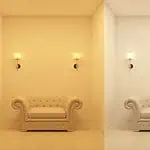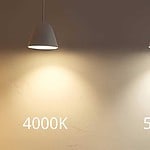Lighting has a crucial role in highlighting the interior of the house. But like everything else, the market offers a range of variety, making it challenging to select the right lights. For most people, the choice ultimately comes down to either 3000K or 4000K. Thus it sparks the debate of 3000K vs 4000K. And since you have clicked on this guide, you are still confused about the right lights for your house.
Simply put, the lights with 3000K temperature produce a warm white color that is ideal for living rooms and bedrooms. Such lights will create a comfortable mood that will help you relax. 4000K lights are excellent for workplaces such as offices and garages because they produce cool, blueish, and bright lights. You would be able to focus better under these lights, consequently increasing productivity.
That said, there is more to this debate than the type of mood they produce. You have to consider several factors, including but not limited to the interior, area, and the paint of the wall. And because each owner has different preferences in these areas, the ideal light temperature cannot be generalized.
Let us walk you through all that so you can make an informed decision.
What Exactly Is Color Temperature and Why Does It Matter?
You can only select the most suitable lights for the home by understanding the color temperature. It essentially is the color that you see when you light a bulb. For example, at 2700K temperature, the LED will have a warmer yellowish glow. But if the light temperature reaches as high as 5000K, it will produce a natural daylight-like glow.
The color temperature of the lights works exactly like heating a piece of metal. When you subject the metal to different temperatures, it will exhibit varying colors at various ranges. For example, steel would appear red at around 2,500 Fahrenheit, but it would turn gray as you dial down the temperature.
Now use the same example but replace the steel with the lighting bulbs. The temperature would be represented by K, which stands for Kelvin temperature and has a range of up to 10000K. Like metal, the LEDs also exhibit varying colors at different Kelvin temperatures. You get warm white, soft white, neutral white, cool white, and bright white at the Kelvin temperatures of 2700, 3000, 3500, 4100, 5000, and 6500, respectively.
Typically, lights with Kelvin temperatures of up to 4000 because anything above that can be too bright and strain the eyes at home. So, ultimately, the choice comes down to anything under that cut-off value, and the 3000K and 4000K turn out to be the best contenders.
Because of a significant difference between the color temperature, naturally, these lights have different characteristics. The most crucial difference is the type of color which determines their utility, the kind of mood they produce, and their impact on health.
3000K vs. 4000K: What Are The Differences?
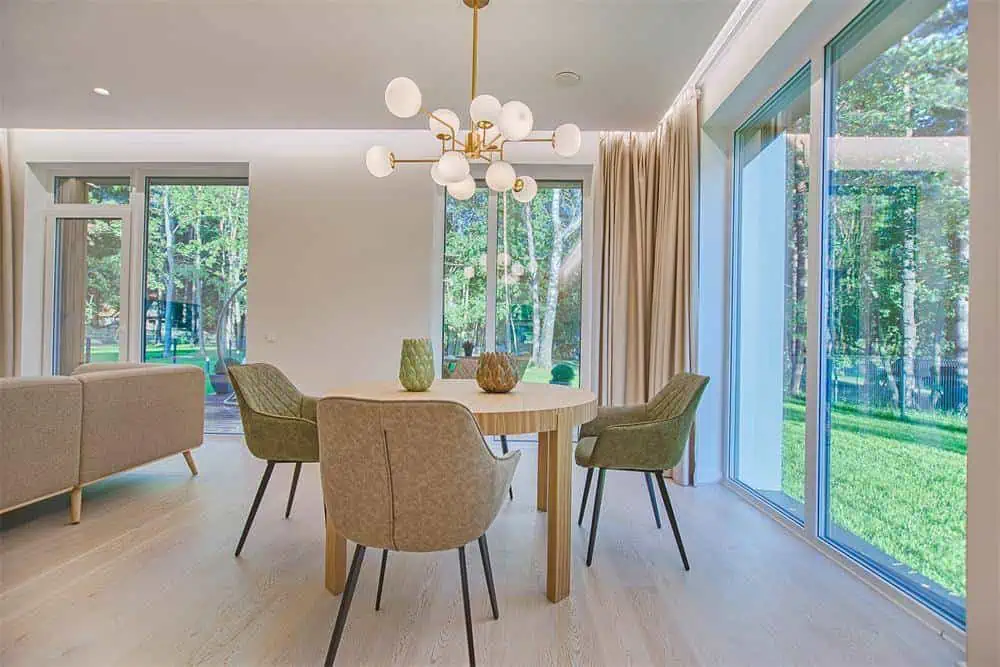
The basic difference between 3000K and 4000K lights is shown in the table but the devil lies in the details. So, let’s take a look at the differences in detail.
| Temperature Color | 3000K | 4000K |
| Color | Warm White | Cool White |
| Ideal For | Bedrooms and Living Rooms | Workplaces & Outdoor Lighting |
| Feel | Cozy | Vibrant |
The most apparent difference between the light types is the color temperature. As discussed earlier, the 3000K lights exhibit a warm white color, whereas 4000K lights lie on the cooler side of the spectrum.
The 3000K light would be ideal for the areas that require a natural light finish. If your home has an earthy tone, the 3000K will highlight its essence. Furthermore, the 3000K LED lights are on the whiter side of the spectrum. They offer a yellower and warmer color similar to an incandescent bulb. Hence, some people may also prefer this range if they look for a traditional look.
On the other hand, the 4000K color temperature looks perfect in areas with a white-coloured interior. It does not just offer more brightness but also highlights elements in the interiors, such as cabinetry in the kitchen and washrooms. Furthermore, 4000K lights also reflect on the white surface inside the house, which makes it look more appealing. That said, it is not recommended to use in homes with earthy or woody tones.
With the 4000K lights, some people are concerned that they might be too bright for them. But it is not the case. This color temperature hangs between yellow and blue, making it suitable for those looking to create a mix of light in their homes. Dimmable LED lights would also work in this situation because you can control their temperature.
The 4000K lights are not too bright and do not pose the harm associated with blue light. Such lights would look incredible in kitchens, living rooms, and bathrooms, especially those with an aesthetic setting.
How To Choose Between 3000K and 4000K?
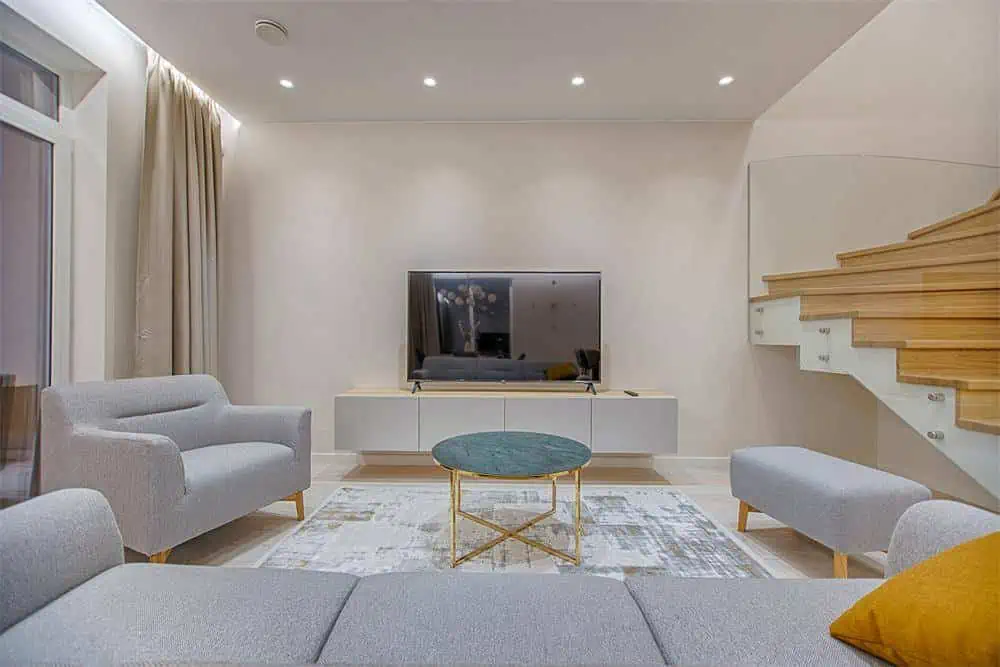
Now that you know the fundamental differences between the two let’s look at the factors that would decide which would fit the best in your home. The significant difference between them is the color, which ultimately comes down to personal preferences. But it would help if you were mindful that different colors trigger various reactions in our bodies. And it must be considered while you are selecting the lighting for the home.
Effect on Mood
Lights that are warm trigger the production of melatonin in our bodies. It is a hormone that regulates our sleep cycle; thus, sitting in such a lighting situation would set the mood for good sleep. The 3000K lights produce such lighting conditions, which makes them suitable for areas like bedrooms and living rooms where you want to relax.
On the other hand, the brighter lights trigger the production of Serotonin which makes the mood energetic. You would be able to focus much better in such lighting conditions. Thus, these lights are appropriate for the areas where you would be working the most.
Utility
In addition to setting the mood and highlighting the interior, lights have another vital role: utility. Different places in the house have varying lighting needs. Areas such as garages have higher lighting needs because there is work to be done there. In these areas, you would be better off with brighter lights, which makes 4000K a natural choice. The more luminosity would allow you to focus and observe the objects more clearly.
3000K lights are not as bright as the 4000K and would be better in places where you typically relax and do not carry out the daily chores. In areas like the living room, it would provide the lighting it needs while maintaining its aesthetics and producing a relaxed mood.
Effect on Health
While selecting the lights for the home, take the health of residents into account as well. People who experience strain on their eyes under direct sunlight should avoid brighter lights such as 4000K. The lights work the same as the Sun; the more colorful they get, the more strain they will produce on the eyes.
That said, the concerns related to blue light emitted by 4000K are greatly exaggerated. It lies on the whiter spectrum and does not threaten the eyes. In contrast, they are making a decision based on health factors in the luminosity of these lights. And if you are okay with it, they have no other harm.
Interior of the Home
The home’s interior should be considered while selecting the appropriate light temperature. While the 4000K lights generally look excellent in Kitchen and Washroom, it might not always be the case. The brighter colors will not highlight the aesthetics if your kitchen has wooden cabinetry and interior. Hence, opting for the 3000K lights might be a better choice in these cases. But if the home has a surface kitchen with white-coloured cabinets, the 4000K lights have no competition.
Applications
Because of the different temperature colors and the effect that they can have on the mood, the applications of the two light types greatly vary. 4000K is perfect for task-lighting and utility work. The serotonin boost from these lights would allow you to focus better and precisely carry out the task. 4000K lights are also better for outdoor lighting, especially for security purposes.
Similarly, if you are looking for lights to enhance the ambience of an area, the 3000K lights would work better. Such lights are also perfect for bedside lamps, even those who love reading. They would provide enough luminosity to let you read without making you too alert and disturbing your partner’s sleep.
3000K vs. 5000K – A Comparison for Better Understanding
While the primary focus of this article is to discuss the differences between 3000K and 4000K, it’s essential to understand how these compare with 5000K lighting as well. This will give you a better perspective on the range of color temperatures available and help you make a more informed decision.
| Temperature Color | 3000K | 4000K | 5000K |
|---|---|---|---|
| Color | Warm White | Cool White | Daylight |
| Ideal For | Bedrooms and Living Rooms | Workplaces, Outdoor Lighting | Office, Commercial Spaces, Task Lighting |
| Feel | Cozy | Vibrant | Energizing |
Color Temperature: As you move up the color temperature scale, the light becomes whiter and brighter. 3000K produces a warm white light, while 4000K offers a cool white light. At 5000K, you get a daylight-like light that is even whiter and brighter than 4000K.
Applications: The applications for each color temperature vary significantly. 3000K is ideal for creating a cozy, relaxing atmosphere in bedrooms and living rooms. 4000K lights are more suited for workplaces, garages, and outdoor lighting, where bright and focused light is needed. On the other hand, 5000K is perfect for office spaces, commercial applications, and task lighting, where maximum brightness and clarity are required.
Effects on Mood: The warmer 3000K light helps create a soothing ambiance, making it suitable for relaxation areas in your home. In contrast, 4000K lights promote alertness and productivity, making them suitable for work environments. 5000K lights offer an even more energizing effect, which is why they are often used in commercial spaces and for task lighting.
In conclusion, when deciding on the best lighting for your home, it’s essential to consider not only the differences between 3000K and 4000K but also how they compare to 5000K. This will help you understand the broader range of color temperatures available and allow you to make the best choice for your specific needs and preferences.
3000K vs. 3500K: A Closer Look at the Differences
Another interesting comparison to consider is between 3000K and 3500K color temperatures. While the difference between these two is not as significant as between 3000K and 4000K, it still plays a role in determining the best lighting option for your home. Let’s dive into the details and use a table to compare these two color temperatures.
| Temperature Color | 3000K | 3500K |
|---|---|---|
| Color | Warm White | Neutral White |
| Ideal For | Bedrooms, Living Rooms | Multi-purpose areas, Kitchens, Bathrooms |
| Feel | Cozy, Relaxing | Balanced, Versatile |
The primary difference between 3000K and 3500K lies in the color temperature. As we know, 3000K produces a warm white light, ideal for creating a cozy and relaxing atmosphere in living rooms and bedrooms. On the other hand, 3500K leans more towards a neutral white color. It sits between the warm and cool ends of the spectrum, making it more versatile and suitable for various applications.
While the 3000K lighting is perfect for areas where relaxation and comfort are the primary goals, 3500K lighting can be used in multi-purpose spaces like kitchens, bathrooms, and hallways, where a slightly cooler and brighter light is desired. The 3500K color temperature balances the warm and cool aspects, providing a comfortable yet invigorating lighting environment.
In summary, when choosing between 3000K and 3500K, consider the purpose and desired ambiance of the space. For a cozy and calming atmosphere, 3000K is the way to go. However, if you need versatile lighting suitable for various tasks and environments, 3500K might be the better choice.
3000K vs. 6000K: A Comprehensive Comparison
In addition to the 3000K vs. 4000K debate, another comparison to explore is between 3000K and 6000K color temperatures. The difference between these two is quite significant, with 6000K leaning towards the cooler end of the spectrum. Let’s take a closer look at the differences between 3000K and 6000K and use a table to compare these two color temperatures.
| Temperature Color | 3000K | 6000K |
|---|---|---|
| Color | Warm White | Daylight White |
| Ideal For | Bedrooms, Living Rooms | Workspaces, Task Lighting, Outdoor Lighting |
| Feel | Cozy, Relaxing | Energizing, Focused |
The most noticeable difference between 3000K and 6000K is the color temperature. While 3000K produces a warm white light ideal for creating a cozy and relaxing atmosphere, 6000K emits a daylight white color that closely resembles natural sunlight. This cooler, brighter light is more suited for areas requiring focus, energy, and high visibility.
While 3000K lighting works well for living rooms and bedrooms, where comfort and relaxation are essential, 6000K lighting is better suited for workspaces, task lighting, and outdoor applications. The daylight white color of 6000K lights helps improve concentration, increase productivity, and enhance visibility in areas where precise tasks are performed or where safety is a concern.
In summary, when choosing between 3000K and 6000K, consider the primary function and desired ambiance of the space. For a cozy, soothing atmosphere, 3000K is the ideal choice. However, if you require energizing, focused lighting for workspaces, task lighting, or outdoor areas, 6000K might be the better option.
Are 4000K LEDs less energy efficient than 3000K LEDs?
The Kelvin temperature of both lights varies greatly, making one wonder whether the 3000K is more energy efficient. But it is not the case because the energy consumption of the LED does not depend on the color temperature. The energy consumed by an LED depends on the heat it omits rather than the color temperature.
Hence, a 3000K LED may consume more energy than 4000K if it produces more heat. You can estimate the amount of heat generated by the LED by understanding the power required to illuminate it, represented by Watts. Generally, 3000K and 4000K lights require 7w. Hence, going with either of these lights would not affect your household’s energy consumption.
Do CCT Adjustable Lights Make a Better Choice?

CCT adjustable lights allow you to switch the color temperature as per your choice. You can also choose LED lights to imitate the natural pattern of sunlight with some options. The best part about these lights is that you can switch from 3000K to 4000K whenever possible. Hence, You can use these lights in all aspects of the home without putting much thought into them. The liberty of changing temperature allows you to set whatever mood you want.
That said, quality CCT adjustable lights might cost slightly more than traditional LED lights. So, if you are running on a budget, consider them only for specific areas. These areas could be where you are unsure about the ideal light temperature.
FAQs
3000K lights are better for the living room because they produce a relaxing mood and are easy on the eyes. 4000K lights are too bright for the living room and would produce unnecessary strain on the eyes.
You should use 4000K lights in places where you want to remain focused. It triggers serotonin production in the body which makes you feel alert. Hence, you would be able to carry out the chores with more accuracy because of a clear view.
It depends on personal preferences and the type of mood you want to set in a certain space. 4000K would not be an ideal pick for areas where you want to relax but they are the perfect choice in areas where you want to get the work done.
Lights with temperatures between 2700-4000K are the best for a home. You can select a range of colors for the different parts of the home depending on the vibe or mood you want to set in those areas.
The 3000K color temperature refers to the warmth or coolness of light emitted by a light source. In this case, 3000K represents a warm white light, leaning more towards a yellowish hue. It is ideal for creating cozy and relaxing environments, such as bedrooms and living rooms.
The brightness of a light source is measured in lumens, not directly related to the color temperature (measured in Kelvins). Therefore, a 3000K light source can have varying brightness levels, depending on the wattage and efficiency of the light source. To know the brightness of a 3000K light, you need to check the lumens output specified by the manufacturer.
In lighting, 3000K indicates the color temperature of the light emitted by a light source. A 3000K light source will produce a warm white light with a slightly yellowish hue. This type of light is well-suited for areas where you want to create a cozy, inviting atmosphere, such as living rooms and bedrooms.
While 3000K lighting creates a warm and cozy atmosphere, it may not be the best choice for every area of your home. Workspaces, such as home offices, kitchens, or garages, might benefit more from cooler lighting, such as 4000K or 5000K. These higher color temperatures provide a more energizing and focused light, making it easier to concentrate and perform tasks.
Although you can use a 3000K light source for task lighting, it may not be the most suitable choice due to its warm, yellowish hue. Cooler color temperatures, such as 4000K or 5000K, provide a brighter and more focused light, which is better for tasks that require concentration and precision. If you need task lighting, it’s advisable to opt for a higher color temperature light source.
Yes, 3000K is considered a warm light. With its warm white color, 3000K lighting creates a cozy, comfortable, and relaxing atmosphere, making it ideal for spaces like living rooms and bedrooms. This color temperature falls on the warmer side of the spectrum, leaning towards a more yellowish hue reminiscent of traditional incandescent bulbs.
Bottom Line
The fundamental and most crucial difference between the 3000K and 4000K lights is the color temperature and the brightness. The 3000K are towards the yellower shade of the spectrum, whereas the 4000K lights lie in the whiter scheme of things. You should choose between them based on the applications, the effect they have on mood, and the type of interior of the house. For more information, you can check Understanding the Differences Between 4000K and 5000K LED Color Temperatures.
LEDYi manufactures high-quality LED strips and LED neon flex. All of our products go through high-tech laboratories to ensure the utmost quality. Besides, we offer customizable options on our LED strips and neon flex. So, for premium LED strip and LED neon flex, contact LEDYi ASAP!
